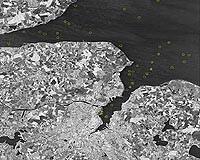 |
Birmingham AL (SPX) Jul 29, 2009 Six University of Alabama at Birmingham (UAB) students and two students from other universities are using satellite imagery to identify possible habitats in Alabama for the black-legged tick that carries and transmits Lyme disease. The students are interns with the NASA-Marshall Space Flight Center DEVELOP Program. DEVELOP is a competitive internship in which students work with NASA and partner-agency scientists to carry out innovative research projects. The eight students are working in UAB's Laboratory for Global Health Observation (LGHO) using data from the NASA Advanced Spaceborne Thermal Emission and Reflection Radiometer (ASTER) sensor on board the Terra satellite, as well as DigitalGlobe QuickBird satellite technology. The technology enables the team to identify the environmental factors in Alabama, specifically the Birmingham metro area, necessary for Lyme disease to occur, said UAB senior Nathan Renneboog, 21, the Marshall DEVELOP team leader. The interns work with an adviser, Senior Research Scientist Jeffrey C. Luvall with the NASA Marshall Space Flight Center. Along with the satellite remote sensing technology, the students are using geographic information systems (GIS) software to generate representations of Alabama in colorful, digital maps on their computer screens. The maps' color patterns detail conditions on the ground such as soil moisture and vegetation that support habitats for black-legged ticks, also known as deer ticks. Animals like the White-tailed deer and the White-footed mouse often are carriers of the ticks and the disease. Ticks carrying the disease often breed in heavily wooded areas. "There has been disagreement among health officials about the degree to which Lyme disease exists in Alabama," Renneboog said. By identifying these habitats, the students want to confirm that conditions are present in Alabama for the disease, he said. On Wednesday, July 29, team members will share their study results with local health officials to help raise public awareness of Lyme disease, Renneboog said. On Aug. 4, Renneboog will present the project results to senior executives at NASA headquarters in Washington, D.C. In addition to Renneboog, a native of Ghent, Belgium, the DEVELOP interns are UAB graduate students Lili Xie of Sichuan, China; Kathryn Roa of Davao, Philippines; Stephen Firsing III of Princeton, N.J.; Shveta Setia of Chandigarh, India; and Ret. Lt. Col. Marilyn McAllister of Athens. The team also includes Boston University student Emily Capilouto of Birmingham and LSU student Kyle Levy of Zachary, La.
What is Lyme Disease? If left untreated, the disease can spread to other parts of the body. If diagnosed early, however, Lyme disease can be treated with antibiotics, experts say. Share This Article With Planet Earth
Related Links University of Alabama Earth Observation News - Suppiliers, Technology and Application
 TerraSAR-X Image Of The Month: Ship ID In Kiel Fjord And Baltic Sea
TerraSAR-X Image Of The Month: Ship ID In Kiel Fjord And Baltic SeaBonn, Germany (SPX) Jul 28, 2009 This image - from the German TerraSAR-X radar satellite - shows the city of Kiel and the Kiel Fjord, an approximately 17-km long fjord or firth of the Baltic Sea on the northeastern shore of Schleswig-Holstein. The ships that were in this area at the time the image was captured are each marked with a circle. The high resolution of TerraSAR-X images makes them ideally suitable for the rapid ... read more |
|
| The content herein, unless otherwise known to be public domain, are Copyright 1995-2009 - SpaceDaily. AFP and UPI Wire Stories are copyright Agence France-Presse and United Press International. ESA Portal Reports are copyright European Space Agency. All NASA sourced material is public domain. Additional copyrights may apply in whole or part to other bona fide parties. Advertising does not imply endorsement,agreement or approval of any opinions, statements or information provided by SpaceDaily on any Web page published or hosted by SpaceDaily. Privacy Statement |